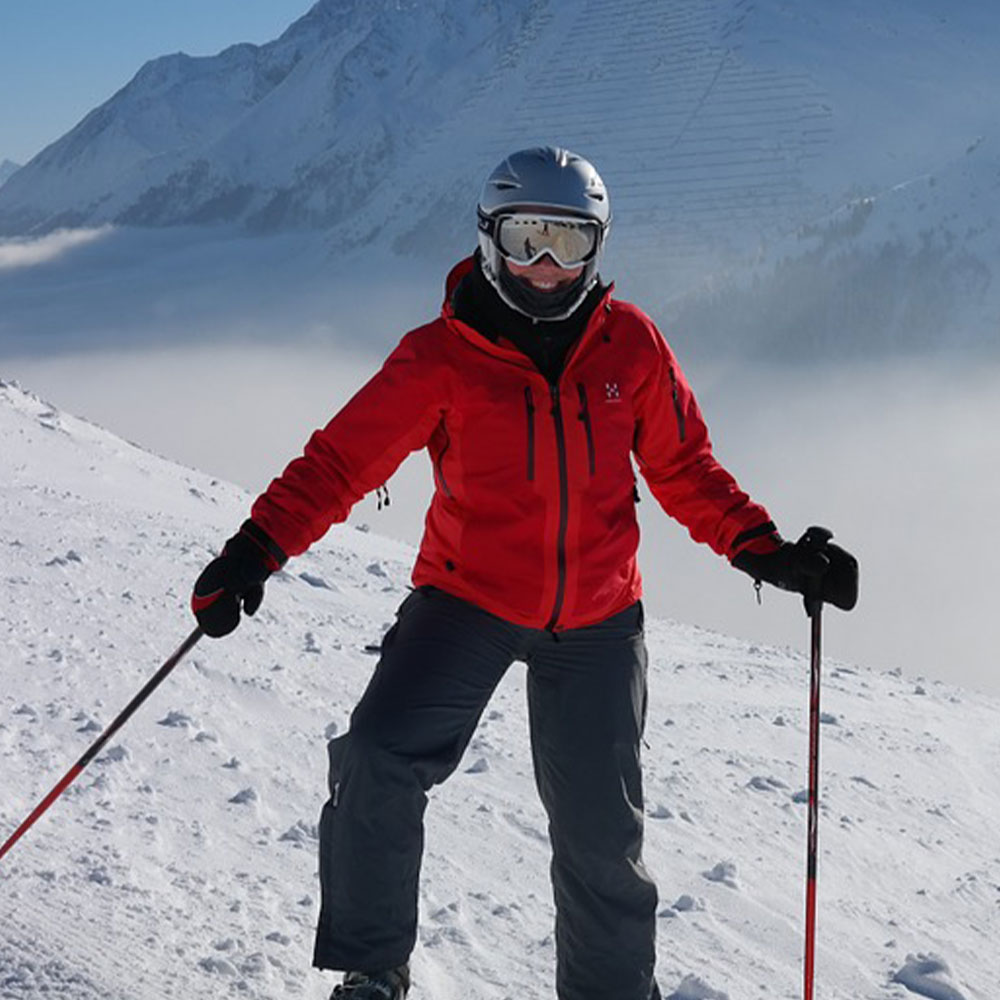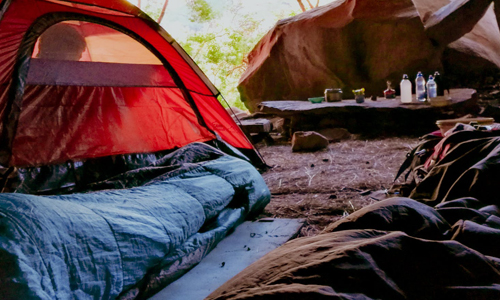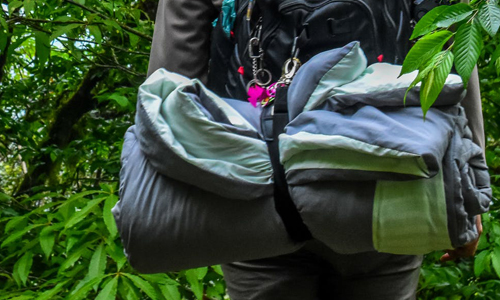Know What Makes up Your Sleeping Bag?
Author

A keen runner, skier and nuts about cycling. Karl lives in Cumbria, where he loves encouraging his two children to follow in his outdoor lifestyle. Whilst out and about keeping active, Karl keeps a diary and shares it with Outdoor Look.
While buying a sleeping bag for a camping trip, we often find ourselves totally confused with all the jargon terminology the salespersons use. We don’t really know what to look for unless we have had some past experience of buying one. Here is a list of all the things that constitute a sleeping bag, so you won’t have to feel awkward while shopping for the next one.
Anatomy and Features of a Sleeping Bag
- The Hood of the Bag
The hood is designed in such a way that ensures  maximum comfort and its insulation preserves the heat inside the sleeping bag.
maximum comfort and its insulation preserves the heat inside the sleeping bag.
- The Shell Casing (Chill, not the bullet kind!)
The shell of a sleeping bag is the fabric that constitutes the exterior of the sleeping bag. The shell fabric or casing as I call it, is far more durable than the inner lining. In some bags, the shell may also include breathable and waterproof fabric technology.
- The Inner Lining
The inner lining is made of a soft and comfortable fabric for ensuring a good sleep. In some sleeping bags, the inner lining may feature a technology that doesn’t let moisture enter or stay inside.
- The Baffle Seams
Baffles in a sleeping bag are what keep the insulation of the bag in place. They are the seams that run through the shell case of the bag.
- The Side-Seams
The side seams are precisely what connect the shell casing’s back and front, for providing a cosy sleeping experience. Some sleeping bags are more thermally efficient as they have ground level seams which help the front shell cover the whole body.
- The Hood-Pocket
The hood of the bag has a pocket that can be used for stuffing clothes or putting a pillow to support your head while sleeping.
- The Draw-Cord Collar
Just like a jacket hood draw-cord collar, some sleeping bags also come with this to prevent heat loss.
- The Head Gasket or Draft Collar
This is what essentially stops the heat from escaping the sleeping bag. It is an insulated collar around the hood of the bag.
- The Stashing Pockets
Not all but some sleeping bags come with extra pockets in the hood, chest or around the feet which help you in stuffing things that you think you might need and keep ready at hand.
- The Insulated Draft Tube
A typical sleeping bag comes with an insulated tube installed around the zipper in order to keep cold drafts from entering the sleeping bag.
- Zipper Tips
Among the sleeping bags, those with no zippers are ideal if you want to travel lightweight. In case you go for half-length zippers, they are still less-heavier as compared to the full-length zipper bags which make regulating the temperature and getting in and out of the bag very easy. On the other hand, two-way zippers are ideal in case you need to access only one of the sides.
- The Trapezoidal Area
The trapezoidal area is where your feet are supposed to rest comfortable. In some sleeping bags, there is enough space for storing hot bottles to keep warm or boot-liners.
- Hanging Loops
Some sleeping bags have loops at the foot of it. The intention is to make it able to hang for drying, while keeping the insulation loft intact.
- Padded Loops
The purpose of pad loops on either side of the bag is to connect with the tent to keep the sleeping bag in place.
Now that you are familiar with the things you need to look for in your sleeping bag, the only thing left is to decide the shape of the bag. You can choose among three options- mummy bags, semi-rectangular bags and rectangular bags. The only difference among them is leg space. Take your pick and you are camp-ready.
Author

A keen runner, skier and nuts about cycling. Karl lives in Cumbria, where he loves encouraging his two children to follow in his outdoor lifestyle. Whilst out and about keeping active, Karl keeps a diary and shares it with Outdoor Look.
Categories
- Sport (28)
- Product Reviews (3)
- Team Outdoor Look (7)
- Mike Wild (2)
- Mike Payton (2)
- Suse Hammond-Pears (3)
- Snowboarding (12)
- Latest Offers (105)
- Shop Talk (1)
- Competitions (7)
- Walking (413)
- Lifestyle Fashion (8)
- Travel (86)
- Kit Guides (176)
- Workwear Clothing (6)
- Safety Workwear (4)
- Health/Fitness (289)
- Skiing (91)
- Great Outdoors (1316)
- Cycling (92)
- January 2025
- December 2024
- November 2024
- October 2024
- September 2024
- August 2024
- July 2024
- June 2024
- May 2024
- April 2024
- March 2024
- February 2024
- January 2024
- December 2023
- November 2023
- October 2023
- September 2023
- August 2023
- July 2023
- June 2023
- May 2023
- April 2023
- March 2023
- February 2023
- January 2023
- December 2022
- November 2022
- October 2022
- September 2022
- August 2022
- July 2022
- June 2022
- May 2022
- April 2022
- March 2022
- February 2022
- January 2022
- December 2021
- November 2021
- October 2021
- September 2021
- August 2021
- July 2021
- June 2021
- May 2021
- April 2021
- March 2021
- February 2021
- January 2021
- December 2020
- November 2020
- October 2020
- September 2020
- August 2020
- July 2020
- June 2020
- May 2020
- April 2020
- March 2020
- February 2020
- January 2020
- December 2019
- November 2019
- October 2019
- September 2019
- August 2019
- July 2019
- June 2019
- May 2019
- April 2019
- March 2019
- February 2019
- January 2019
- December 2018
- November 2018
- October 2018
- September 2018
- August 2018
- July 2018
- June 2018
- May 2018
- April 2018
- March 2018
- February 2018
- January 2018
- December 2017
- November 2017
- October 2017
- September 2017
- August 2017
- July 2017
- June 2017
- May 2017
- April 2017
- March 2017
- February 2017
- January 2017
- December 2016
- November 2016
- October 2016
- September 2016
- August 2016
- July 2016
- June 2016
- May 2016
- April 2016
- March 2016
- February 2016
- January 2016
- December 2015
- November 2015
- October 2015
- September 2015
- August 2015
- July 2015
- June 2015
- May 2015
- April 2015
- March 2015
- February 2015
- January 2015
- December 2014
- November 2014
- October 2014
- September 2014
- August 2014
- July 2014
- June 2014
- May 2014
- April 2014
- March 2014
- February 2014
- January 2014
- December 2013
- November 2013
- October 2013
- September 2013
- August 2013
- July 2013
- June 2013
- May 2013
- April 2013
- March 2013
- February 2013
- January 2013
- December 2012
- November 2012
- October 2012
- September 2012
- August 2012
- July 2012
- June 2012
- May 2012
- April 2012
- March 2012
- February 2012
- January 2012
- December 2011
- November 2011
- October 2011
- September 2011
- August 2011
- May 2010
- April 2010
- March 2010
- February 2010
- January 2010
- November 2009
- October 2009
- September 2009
Submit a Comment